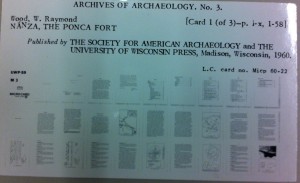Are you looking for a chance to combine your interests in archaeology and digital data? Then why not apply for a two year position at Arizona State University as a Postdoctoral Fellow with tDAR, the Digital Archaeological Record. tDAR is an international repository containing archaeological reports, images, data sets, and other related digital files. It is part international repository, part research tool, and part public access tool.
As a Postdoc you will be based at Arizona State University’s Center for Digital Antiquity, in Hayden Library on the Tempe campus. You will work on a research team with archaeologists, programmers, librarians and data managers exploring new ways to help researchers more effectively create, preserve, integrate and analyze knowledge of the human past. To learn more about the position and how to apply visit http://www.clir.org/fellowships/postdoc/applicants/asu2013. Applicants must have completed a Ph.D. in Anthropology with a specialization in archaeology, or a Ph.D. in Archaeology or a closely related field, at the time of appointment.
This Postdoctoral Fellowship in Data Curation for the Sciences and Social Sciences is made possible by the Council on Library and Information Resources (CLIR/DLF).
